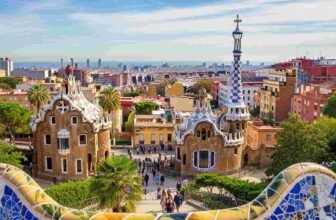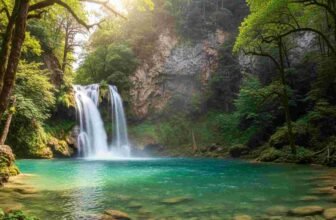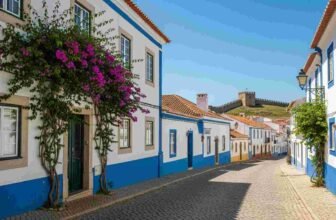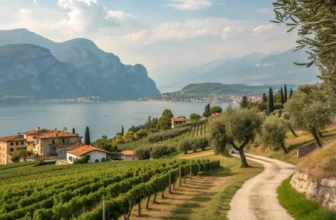
There’s a kind of quiet the modern world forgot—where footsteps echo off cobblestones, and the loudest sound is a church bell or a breeze through shutters. In these rare places, cars are banned, time slows down, and life feels beautifully untouched. No honking. No rushing.
Just pure, old-world magic. If you’ve ever craved a deeper kind of escape—the kind that doesn’t involve traffic or tour buses—this is your moment. These villages aren’t just scenic; they’re soul-resetting. And once you see them, you’ll wonder why we ever traded charm for chaos. Ready to step back in time? Let’s wander.
1. Giethoorn, Netherlands – The “Venice of the North”

Tucked away in the Dutch province of Overijssel, Giethoorn looks like something out of a watercolor painting. The village has no roads at all, just peaceful canals winding between charming thatched-roof cottages and gardens so pristine you’d swear they were fake. Instead of cars, locals get around by “whisper boats”—small electric vessels that glide silently through the water. It’s not only picturesque, but it’s also eerily quiet in the best way possible.
I visited in the spring, and I still remember how surreal it felt to hear nothing but the gentle ripple of water and the occasional duck quacking like it owned the place. Walking paths and quaint wooden bridges connect the houses, making it feel like you’re drifting through a Dutch fairy tale. There’s a small museum, local eateries, and adorable shops that sell handmade goods—just enough to keep you enchanted without overwhelming the peace.
While the village has gained popularity with tourists, it hasn’t lost its soul. Giethoorn isn’t just a place—it’s an experience in slowness. You come here to breathe, float, and wander without a single honk or traffic light in sight.
Travel Tips for Giethoorn:
- Best Months to Visit: April to June for tulip season and quieter crowds
- How to Get There: Train to Steenwijk, then bus or taxi
- Must-Do: Rent a whisper boat and drift along the canals yourself
- Nearby Treat: Visit De Weerribben-Wieden National Park for cycling and birdwatching
- Local Food to Try: Dutch pancakes (pannenkoeken) by the canal!
2. Zermatt, Switzerland – Alpine Charm Without the Engines

Nestled at the foot of the iconic Matterhorn, Zermatt is a snow globe village where cars are completely banned, and the only thing crunching under your feet is snow or cobblestones. It’s primarily known as a world-class ski destination, but even if you’re not into slopes, this place will steal your heart with its timber chalets, crisp air, and dramatic mountain skyline.
Here, electric taxis and horse-drawn carriages are the only transportation allowed within the village, and that’s part of what makes the air so fresh and the vibe so peaceful. You’re encouraged to walk, hike, or ski between destinations, and somehow everything feels cozy, clean, and refreshingly human. It’s a great escape from urban madness.
I remember sitting at a café terrace with a hot chocolate, watching the sun catch the snowy peak of the Matterhorn while children built snowmen nearby—it was like living in a snow-dusted postcard. Zermatt isn’t just stunning; it’s soul-soothing.
Travel Tips for Zermatt:
- Best Months to Visit: December to March for skiing or July to September for hiking
- How to Get There: Take the train to Zermatt—cars must be parked in Täsch
- Must-Do: Ride the Gornergrat Railway for insane panoramic views
- Don’t Miss: Glacier Paradise—Europe’s highest cable car station
- Pro Tip: Bring layers—mountain weather shifts fast!
3. Civita di Bagnoregio, Italy – The “Dying” City That Lives On

Civita di Bagnoregio is the stuff of Italian legends. Perched atop a crumbling volcanic plateau in central Italy, this ancient hilltop village is accessible only by a long pedestrian bridge. No cars, no mopeds, not even bicycles. And that’s exactly what makes it magical. It’s often called “La città che muore” (The Dying City), but it’s very much alive with charm, character, and haunting beauty.
The village is small—tiny, even—and most of its stone buildings date back to Etruscan and medieval times. You’ll find no chains, no traffic, and no rush. Just narrow lanes, old churches, family-run trattorias, and cats lounging in the sun. Everything about Civita feels like you’re walking through the bones of history—and hearing it whisper back.
I’ll never forget the moment I crossed the bridge at sunset. The golden light lit up the stone walls like they were glowing from within. And once inside the village, the stillness felt like a secret too sacred to disturb. It’s not flashy—but it’s unforgettable.
Travel Tips for Civita di Bagnoregio:
- Best Months to Visit: May to October for good weather and blooming gardens
- How to Get There: Train to Orvieto or Viterbo, then taxi or local bus
- Must-Do: Explore the small museums and the Church of San Donato
- Photo Spot: The long footbridge with the village in full view
- Local Dish to Try: Handmade pici pasta with wild boar ragù
4. Hydra, Greece – Where Donkeys Rule the Roads

Imagine a Greek island where cars, motorbikes, and even bicycles are banned. Welcome to Hydra, a gem in the Saronic Gulf, just two hours by ferry from Athens. The only sounds you’ll hear are waves, seagulls, and the clop of donkey hooves on stone paths. Yes, donkeys are still the main form of transport here—and that’s part of the charm.
Hydra is full of sun-bleached mansions, bougainvillea-covered alleyways, and laid-back harborside cafés. The pace is slow, the views are dreamy, and the lack of noise pollution is so noticeable you’ll wonder why the whole world doesn’t live this way. This isn’t just a retreat—it’s a reset button.
When I stayed here, I didn’t wear shoes half the time. I’d stroll to the harbor barefoot in the morning, grab a Greek coffee, and spend the day walking the cliffs or diving into clear blue coves. Hydra feels like what summer is supposed to be—quiet, simple, and sun-drenched.
Travel Tips for Hydra:
- Best Months to Visit: May, June, and September—before or after peak heat and crowds
- How to Get There: Ferry from Athens (Piraeus Port) in 2 hours
- Must-Do: Walk the coastal path to Kamini for a swim and seaside lunch
- Unique Experience: Ride a donkey through town
- What to Pack: Swimsuit, sandals, and a good book
5. Rothenburg ob der Tauber, Germany – Medieval Perfection

Stepping into Rothenburg ob der Tauber feels like stumbling into a Brothers Grimm fairy tale. With its timbered houses, cobbled streets, and massive medieval walls, the town has preserved its history so well you half expect a knight to ride by. While cars aren’t completely banned, the historic center is largely pedestrian-only, making it easy to lose yourself in its magic.
It’s especially known for its Christmas Market, but honestly, any season is spellbinding. The atmosphere is delightfully old-school—think wrought iron signs, flower boxes, and charming little shops selling wooden toys and handmade ornaments. At night, the lantern-lit streets feel almost enchanted.
I joined the famous Night Watchman Tour—a mix of storytelling, history, and humor—and by the end, I was convinced the Middle Ages had been paused just for us. Rothenburg isn’t just well-preserved—it’s alive in the most storybook kind of way.
Travel Tips for Rothenburg ob der Tauber:
- Best Months to Visit: May to September for mild weather; December for the Christmas Market
- How to Get There: Train from Nuremberg or Würzburg
- Must-Do: Walk the medieval city wall
- Hidden Gem: Käthe Wohlfahrt’s year-round Christmas store
- Try This: Schneeballen (a local pastry that looks like a sugar-dusted snowball)
6. Oia, Santorini, Greece – Whitewashed Wonder Without the Whirr

Perched on the caldera cliffs of Santorini, Oia is known for its sunsets that stop people in their tracks, blue-domed churches, and whitewashed homes stacked like sugar cubes along the hillside. But what many don’t realize until they arrive? Cars aren’t part of the picture here. The winding paths are too narrow and steep—made only for your feet (and the occasional donkey).
There’s something intimate about exploring this village without the hum of engines. You wander through mazelike alleys that suddenly open into jaw-dropping vistas of the Aegean. Boutique shops, art galleries, and tucked-away cafés reveal themselves like secrets. And when the sun begins to dip into the sea, everyone pauses—strangers turning into a shared audience for nature’s show.
I stayed in a cave house here once—carved right into the cliff—and waking up to that view? It’s the kind of peace you carry with you forever. The village asks you to slow down, walk barefoot, and let the rhythm of island life take over.
Travel Tips for Oia:
- Best Months to Visit: April to early June, or September to October—avoid July/August crowds
- How to Get There: Fly into Santorini, take a local bus or taxi to Oia (cars stop outside the pedestrian zone)
- Must-Do: Watch the sunset from the Oia Castle ruins
- Pro Tip: Book accommodations well in advance—many spots are boutique-sized
- Try This: Tomato keftedes (fried tomato balls) and local Assyrtiko wine
7. Fes-al-Bali, Morocco – Ancient Walls, Living History

Okay, a curveball—but a worthy one. While Fes-al-Bali is technically outside of Europe, it’s often looped into Euro-Mediterranean travels due to its proximity and historical ties. This UNESCO-listed medina in Morocco is one of the largest car-free urban zones in the world—and once you’re in, you’ll understand why.
Inside the thick medieval walls, over 9,000 narrow alleys wind past souks, hidden courtyards, mosaic-tiled riads, and ancient mosques. It’s chaotic, colorful, and completely alive. Motor vehicles simply can’t fit—and that’s a blessing in disguise. You’ll dodge donkeys and traders instead, with scents of leather, spices, and mint tea guiding you around corners.
My first walk through Fes felt like being transported—not just back in time, but into another sensory realm entirely. It’s overwhelming in the best way. If you’re a traveler who loves history you can smell, touch, and taste, this place delivers like no other.
Travel Tips for Fes-al-Bali:
- Best Months to Visit: March to May and September to November for cooler weather
- How to Get There: Fly into Fes-Saïs Airport, take a taxi to the medina gates
- Must-Do: Visit the Chouara Tannery and the world’s oldest university (Al-Qarawiyyin)
- Bring This: A map or guide—it’s a labyrinth (and that’s not a metaphor)
- Don’t Miss: Fresh mint tea on a rooftop terrace at sunset
8. Hallstatt, Austria – Quiet Reflections in the Alps

Nestled on the western shore of a serene alpine lake, Hallstatt is the sort of place that makes you whisper when you speak. The historic town center is car-free, preserving the peaceful atmosphere that makes this Austrian gem so soul-soothing. Timber-framed houses with window boxes burst into bloom in spring, and in winter, snow dusts the rooftops like a postcard brought to life.
You can only explore the village on foot—or by electric boats gliding over the glassy lake. The quiet is tangible. You’ll hear the church bells, the water lapping, and the crunch of your steps along cobblestones. It’s the kind of silence that feels sacred.
What stood out to me? The stillness of the lake at sunrise. Locals were just setting out flowerpots, and the entire town seemed to hold its breath. Hallstatt doesn’t need to shout—it whispers beauty in every corner.
Travel Tips for Hallstatt:
- Best Months to Visit: May to October; December for a magical snow-globe feel
- How to Get There: Train to Hallstatt Station + ferry across the lake
- Must-Do: Take the funicular to the salt mine and Skywalk
- Stay Overnight: Most tourists day-trip—so evenings and early mornings are more peaceful
- Must-Try: Apple strudel with vanilla sauce at a lakeside café






